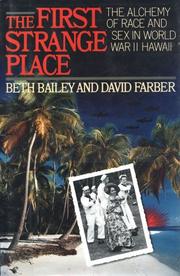

THE FIRST STRANGE PLACE
The Alchemy of Race and Sex in World War II Hawaii
by Beth Bailey & David Farber
Thoughtful, low-key survey of WW II Hawaii—the ``first strange place'' for almost a million US soldiers, sailors, and Marines. After an obligatory Day of Infamy prologue, Bailey and Farber (both American History/Barnard College) take a look at pre-WW II America, an innocent and provincial nation not yet homogenized by TV or hardened by modern war, and one in which future soldiers from Kansas, Georgia, and New York could barely understand one other. The authors then discuss the Hawaii of that time, an isolated, colonial territory dominated by a white oligarchy and five large companies, but with—as the resourceful Mabel Thomas, proprietor of the era's Malahuai dance palace, noted—``Hawaiians, Japanese, Chinese, Filipino, Portuguese, Puerto Rican, Spanish, Javanese, [and] Malayan'' women mixing it up on the dance floor. The onslaught of mainland soldiery into this melting pot created a potent situation, with tens of thousands of male war-workers, most of them living in vast barracks, forming lines around the block leading to whorehouses (supported as a necessity by the local elite) that stank of sweat, cigarettes, and disinfectant, while surrounding them stood the fragile local culture. Bailey and Farber don't catch the ear as Somerset Maugham did in describing South Seas life, or as James Jones did in detailing the ways of WW II soldiers; nor do they have the epic narrative line of some other recent WW II histories like George Feifer's Tennozan (p. 368). What they do create here, supported by quotations from diaries and letters of the time, is a sense of a vast, restless bus terminal where no one is at home or at ease, populated by men itchy with testosterone, fear, and disorientation as their boundaries and expectations are violated—especially true in the case of southern whites. An engaging study, shedding relevant historical light on today's multiethnic America.